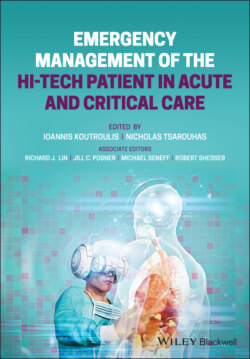Читать книгу Emergency Management of the Hi-Tech Patient in Acute and Critical Care - Группа авторов - Страница 33
Stomal Bleeding
ОглавлениеBleeding at the stomal site is one of three things: hypergranulation tissue, mucosal irritation with or without prolapse, and upper GI bleeding. Distinguishing between the three is important because, while, to the patient they may all be an emergency, the severity and treatment are dramatically different.
A granuloma is a well‐circumscribed, pearly piece of tissue adherent to the stoma (Figure 1.4a). It presents as chronic, low‐grade bleeding. Its cause is unknown, but it is thought to arise from repetitive trauma from the G‐tube rubbing against the stoma. Hypergranulation tissue is of low risk but causes significant distress among patients and caregivers. Treatment is largely topical, including 0.1% triamcinolone cream, commercially available granuloma‐reducing agents, and salt packing. These agents are not without risk; specifically, triamcinolone can cause skin thinning, systemic absorption, and may precipitate a fungal infection. Silver nitrate application, kenalog injections, electrocautery, and G‐tube site revision are used in more persistent cases.
Another cause of chronic mild stomal bleeding is mucosal irritation. This too is caused by repetitive movement of the tube within the stoma and can be quickly resolved with properly sizing the tube. In addition, gauze and tape can be used to better secure the tube in position.
Finally, acute stomal bleeding is either prolapsed stomal tissue or upper GI bleeding. Prolapsed gastric tissue has a deeper red color compared to the color of a granuloma, and it is acute not chronic (Figure 1.4b). This distinction is important because silver nitrate would injure the gastric mucosa and should not be used in the setting of gastric tissue prolapse. Prolapse can be treated with the application of salt or sugar to shrink the gastric tissue and then firm and steady pressure to direct the tissue back into the stomal site. If this is unsuccessful, general surgery should be consulted. Significant stomal site bleeding without prolapsed tissue, skin irritation, or granuloma development is upper GI bleeding, until proven otherwise, and should be evaluated by endoscopy.
Figure 1.4 (a) Granuloma notable for its pearly color and irregular shape. (b) Prolapse distinguished from granuloma by the deeper erythema and more uniform shape.
